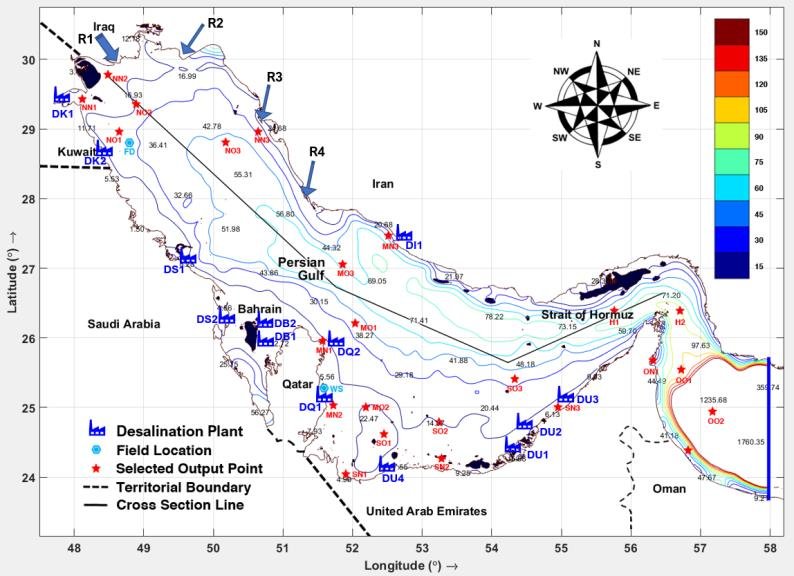Discover how desalination plants are contributing to thermal pollution in the Persian Gulf. Learn about ecological impacts, case studies, innovative mitigation strategies, and what this means for the future of marine sustainability.

Location map of desalination plants in the Persian Gulf with the Gulf bathymetry. Credit: DOI: 10.9753/icce.v36.papers.3
Why Thermal Pollution from Desalination Matters
The Persian Gulf, surrounded by some of the world’s driest countries, is paradoxically one of the most desalinated water bodies on Earth. Every day, millions of cubic meters of seawater are transformed into drinking water through desalination. But there’s a hidden cost—thermal pollution.
When desalination plants discharge hot brine back into the sea, it raises local water temperatures, alters salinity, and disrupts marine ecosystems already living on the edge. In an environment where sea temperatures can already reach 35°C in summer, even a small thermal increment can tip the ecological balance.
This matters not only to marine species but to the millions of people relying on Gulf fisheries, the maritime industry operating in these waters, and climate-conscious governments seeking sustainability. As desalination scales up to meet growing water demand, it’s time to ask: can we meet human needs without boiling the sea?
The Mechanics of Desalination and Thermal Pollution
Desalination is the process of removing salt and impurities from seawater to produce fresh water. The Persian Gulf region accounts for more than 50% of the world’s desalination capacity, with over 70 operational plants in Saudi Arabia, UAE, Kuwait, Qatar, Bahrain, Oman, and Iran (UNEP, 2023).
There are two primary methods:
-
Thermal Desalination (Multi-Stage Flash or Multi-Effect Distillation): Uses heat to evaporate seawater, which is then condensed.
-
Reverse Osmosis (RO): Pushes seawater through semi-permeable membranes to remove salt, usually requiring less thermal energy but still needing power.
Both methods result in:
-
Brine discharge – High in salinity and often 5–10°C warmer than intake seawater.
-
Chemical discharge – Contains anti-scalants, biocides, and residual chlorine.
-
Thermal plumes – Persist in the surrounding water, especially in shallow coastal zones with limited tidal flushing.
A study by Marine Pollution Bulletin (2022) found that temperatures near desalination outfalls in the UAE and Kuwait were consistently 2–5°C higher than ambient waters, a significant margin in ecosystems already close to thermal thresholds.
Environmental Impacts: What’s at Stake?
Coral Reefs and Heat Stress
Corals are incredibly sensitive to temperature. Even a 1°C sustained increase can trigger bleaching, and the Gulf’s corals are already among the most heat-tolerant on Earth. But they have limits. The World Wide Fund for Nature (WWF) notes that more than 40% of coral cover near coastal desalination zones in Bahrain and Qatar has declined in the past two decades.
Coral bleaching weakens reef structure, reducing habitat availability for thousands of marine species and disrupting the food web.
Seagrass Beds and Mangroves
Seagrass meadows, essential for stabilizing sediment and supporting biodiversity, are harmed by increased turbidity and warmer waters. Warmer brine also accelerates hypoxia (oxygen loss), reducing resilience in nearby mangrove forests.
A 2021 paper in Ocean Engineering showed that thermal brine plumes can persist up to 3 km from discharge points, affecting benthic organisms and increasing the risk of eutrophication.
Fish Stocks and Commercial Species
Thermal pollution alters spawning cycles and habitat preferences. Species like grouper, shrimp, and mullet—important for Gulf fisheries—tend to avoid warmer discharge zones. This creates dead zones, pushing fishers to venture further offshore, increasing fuel use and economic burden.
The Gulf’s annual fishery yields have dropped by 15–20% in affected zones since 2000, according to FAO regional statistics.
Real-World Examples and Local Responses
Case Study: UAE’s Jebel Ali Desalination Complex
The Jebel Ali facility, one of the largest desalination plants globally, produces over 2 million m³ of water per day. Located near coral-rich waters, the plant faced public pressure and environmental concern due to visible coral bleaching.
In 2020, DEWA (Dubai Electricity and Water Authority) introduced a new diffuser-based brine dispersion system, spreading the discharge across a wider area to lower temperature intensity. Early data from the Emirates Marine Environmental Group (EMEG) showed a 20% recovery in coral health by 2023.
Case Study: Shuaiba and Shoaiba Plants, Saudi Arabia
Saudi Arabia’s twin giants, Shuaiba and Shoaiba, together contribute over 4 million m³/day of desalinated water. But their location along semi-enclosed shorelines makes them prone to thermal stagnation.
The Saline Water Conversion Corporation (SWCC) partnered with King Abdullah University of Science and Technology (KAUST) to implement a deep-water brine pipeline, relocating thermal discharge 8 km offshore. Initial results have shown a 3°C reduction in nearshore thermal loads, according to KAUST Environmental Reports (2023).
Technology and Innovation: Hope in Engineering
Energy Recovery and Hybrid Systems
Modern desalination plants are exploring waste heat recovery to reduce thermal emissions. Hybrid systems combining RO and thermal distillation use less energy and produce cooler brine.
Companies like Wärtsilä and SUEZ Water Technologies are developing zero liquid discharge (ZLD) pilot systems that reclaim heat and recycle concentrate into usable products like industrial salts.
Subsurface Brine Diffusion
Instead of surface discharge, some newer facilities—like Oman’s Al Ghubrah plant—are using subsurface diffusers, injecting brine into sediment layers, allowing it to dissipate before mixing with the open sea.
Satellite Monitoring and AI Modelling
Projects like Inmarsat’s OceanIQ and ESA’s Copernicus Marine Environment Monitoring Service (CMEMS) are tracking thermal plumes using satellite thermal imaging. These tools help regulators and scientists map long-term impacts and evaluate mitigation measures.
AI tools are now being deployed to model thermal dispersion and cumulative stress in nearshore ecosystems, offering predictive capacity for future plant expansions.
Regulatory Frameworks and Regional Gaps
IMO and International Guidelines
While thermal pollution is less regulated than chemical discharges, the International Maritime Organization (IMO) has encouraged member states to monitor brine salinity and temperature under MARPOL Annex V and VI, especially for floating desalination units.
The World Bank MENA Water Initiative (2022) also emphasizes the need for environmental impact assessments (EIAs) that include thermal mapping and cumulative impact evaluation.
National Guidelines
-
UAE: Requires Thermal Impact Zones (TIZ) to be mapped and monitored quarterly under federal law.
-
Saudi Arabia: Environmental permits mandate ecological assessments within a 5-km radius.
-
Qatar and Bahrain: Have begun integrating marine spatial planning (MSP) into desalination zoning decisions.
Despite these steps, enforcement and transparency vary. According to Marine Policy (2023), only 35% of Gulf desalination plants publish environmental performance reports.
Future Outlook: Can We Cool the Gulf?
Thermal pollution from desalination won’t vanish overnight. But coordinated action, smarter technology, and public accountability can mitigate damage.
Regional Solutions
The Regional Organization for the Protection of the Marine Environment (ROPME) could play a stronger role in standardizing discharge protocols and thermal plume modeling across member states.
Joint initiatives—like the Persian Gulf Ecological Restoration Alliance (PGERA)—could pool expertise and funding to rehabilitate coral reefs and seagrass meadows near impacted zones.
A Greener Path Forward
Countries like the UAE and Saudi Arabia are investing in solar-powered desalination, significantly reducing thermal discharge and carbon footprints. Pilot projects in NEOM (Saudi Arabia) and Masdar (UAE) aim to create off-grid, carbon-neutral desalination prototypes by 2030.
With the IMO’s 2023 GHG Strategy targeting net-zero emissions from maritime industries by 2050, desalination technology will be under growing scrutiny to align with blue economy values.
Frequently Asked Questions (FAQ)
What is thermal pollution from desalination?
It refers to the discharge of warm water (brine) back into the sea after the desalination process, raising local sea temperatures and affecting marine ecosystems.
Why is the Persian Gulf especially vulnerable?
Its shallow depth, high evaporation, and limited water circulation make it more susceptible to temperature increases and hypersalinity.
Are desalination plants being regulated for thermal discharge?
Yes, but unevenly. Some countries have strict monitoring protocols; others lack enforcement or data transparency.
Can marine life recover from thermal pollution?
Recovery is possible, particularly for coral and seagrass, if stressors are removed and restoration efforts are applied. However, prolonged exposure can cause irreversible damage.
Are there sustainable alternatives to current desalination practices?
Yes—solar desalination, waste-heat recovery, hybrid systems, and zero-liquid discharge technologies offer more environmentally friendly options.
Is reverse osmosis better for the environment?
Generally yes, as it consumes less energy and emits cooler brine. However, it still has a footprint due to chemical use and membrane waste.
What role do maritime professionals play in this issue?
From environmental officers at ports to engineers managing discharge systems, maritime professionals are crucial in monitoring, reporting, and innovating greener practices.
Conclusion
Desalination is a lifeline for Persian Gulf nations—but its byproduct, thermal pollution, is silently stressing an already fragile marine ecosystem. The good news? Solutions exist. Through technological innovation, stricter regulation, and regional cooperation, we can strike a better balance between quenching human thirst and preserving the Gulf’s underwater world.
As the region moves toward sustainable development and climate resilience, the challenge is clear: desalinate wisely, or risk turning a life-giving sea into a hot, lifeless basin.

